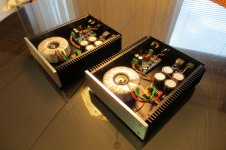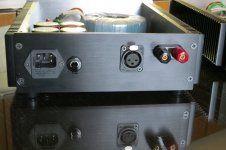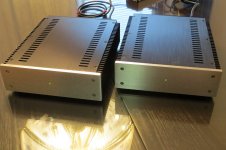Tom, I find your Mod-86 amps VERY suitable for driving my 100dB/W/M Unity horns above 300Hz, even to unreasonable listening levels. They would be fine for lower efficiency drivers too if the bandwidth was restricted to above ~300Hz only. If they were driving a <85dB/W/M speaker full range I would find them only suitable for an apartment system, where high levels are not required (or desired).
Luckily the punters have some choice and can power up their systems if required.
Luckily the punters have some choice and can power up their systems if required.

105dB/1W/1m checking in. Modulus-86 is superb, driving 33Hz-20kHz. Completely and totally adequate at extremely loud levels with no clipping and just the slightest bit of warmth from the sides of a Dissipante 3U case.
Last edited:
96dB/2.83V/1m checking in. Modulus 86 when I owned it would blast me out of the room. With my soon to be completed 286, I anticipate no clipping, only singing. System involves asymmetrically placed multiple subs and my 96dB mains are limited to about 50Hz.
Best,
Anand.
Best,
Anand.
What I'm hearing could easily be caused by the speaker drivers, MiniDSP, room, etc. as well. That's why measurements would be rather handy to have.
That said, there is a pretty clear use case for high-powered amps, especially in multiway systems with active filters.
Tom
That said, there is a pretty clear use case for high-powered amps, especially in multiway systems with active filters.
Tom
I just put my Mod-86 built in spring 2015 (Rev 1.0 boards, see post 692) back in my main system and want to thank Tom again for a simply wonderful amp at a very reasonable cost. Holds its own with units costing multiples more.
Thank you, thank you, thank you!
Thank you, thank you, thank you!
I've been driving both my Fostex horn/reflex hybrids (8 ohm, sensitivity somewhere above 90dB/m/W) and my Mission 750LEs (6 ohm, sensitivity around 85dB/m/W) and have had no trouble with either, but I designed my system so that even unattenuated the maximum signal from the digital source cannot cause the Modulus-86s to clip. Digital volume control is disabled, I handle volume in the analogue domain with a stepped attenuator, so unless I have a clipped source file the Modulus-86s are never going to clip. I've been very happy with their sound. Realistically, except for testing purposes I'm never going to have them turned up, even with the lower efficiency Missions full volume is too loud for a semi-detached house, I would upset the neighbours!
I'm planning to add another Modulus to my collection soon, to drive a subwoofer project: probably another Modulus-86, for the upsetting-the-neighbours reasons above. A Modulus-86 run at +-38V regulated should provide the perfect amount of power to drive a Dayton Audio RSS265 8 ohm 10" driver.
I'm planning to add another Modulus to my collection soon, to drive a subwoofer project: probably another Modulus-86, for the upsetting-the-neighbours reasons above. A Modulus-86 run at +-38V regulated should provide the perfect amount of power to drive a Dayton Audio RSS265 8 ohm 10" driver.
I feel the need for a 'clip86' add on board so you get a red light when over-driving. Like Adrian I'm setting up so I cannot overdrive the input and my speakers don't present any nasty 2 Ohm reactive loads. The Sub, once comissioned will also take LF load off the system.
I feel the need for a 'clip86' add on board so you get a red light when over-driving.
I've been mulling over that, actually. All one has to do is to detect the input differential voltage of the LME49710. If that deviates significantly from zero, the amp is clipping. The trick is to do so reliably and cleanly. I'd probably also want to play a bit with the timing of the light itself to ensure that even a brief clip will be indicated.
Tom
It's a common feature on the various amplifier modules intended for OEM use. ICEpower, Hypex, Pascal, et al. all have clip/overload detectors.
Tom
Tom
True, though Crown or whomever advertised it as a linearity indicator rather than a clip indicator.
Put an inverter on the CLIP output and you have a LINEAR indicator... 🙂 
Somehow I'm not surprised that someone used clever marketing to highlight that their box had a CLIP indicator. That sounds like something out of the late 1970ies or 1980ies.
Tom

Somehow I'm not surprised that someone used clever marketing to highlight that their box had a CLIP indicator. That sounds like something out of the late 1970ies or 1980ies.
Tom
Dang! I love when we're both right. From Ben Duncan, "High Performance Audio Power Amplifiers": "Crown's patented IOC (Input-Output Comparator) scheme first appeared in 1977 on their DC300A-II. In this and the subsequent related schemes used by other makers, the input and output are compared with the transfer function subtracted. If input differs substantially from the output (less the normal gain and phase differences), the amplifier must be clipping, shorted, slew limiting – or otherwise sick, due to RF oscillation or a 'DC fault'. If so a (sic) LED marked 'IOC' or 'Clip' or 'Error' lights."
Tom
Tom
More from Samsung-owned Harman Kardon-owned Crown: https://www.google.com/url?sa=t&rct...original.pdf&usg=AOvVaw3jNwHrE267JZLMKlSdumVe
In case the link doesn't work, I've attached the linked .pdf here.
Tom
In case the link doesn't work, I've attached the linked .pdf here.
Tom
Attachments
Interesting that in their own literature they'd refer to one of their most famous products as "300 Watts and a Cloud of Smoke".
Surely a lot of hype for a relatively simple function. The trick is to incorporate into your amps, which have less distortion by several orders of magnitude, and not mess up distortion and/or stability. I expect it can be done without too much trouble.
Surely a lot of hype for a relatively simple function. The trick is to incorporate into your amps, which have less distortion by several orders of magnitude, and not mess up distortion and/or stability. I expect it can be done without too much trouble.
After some time, making a nice sound on a wooden plate, I decided these small beasts needed a pair of nice monoblock chassis 😀
Attachments
Last edited:
I've been mulling over that, actually. All one has to do is to detect the input differential voltage of the LME49710. If that deviates significantly from zero, the amp is clipping. The trick is to do so reliably and cleanly. I'd probably also want to play a bit with the timing of the light itself to ensure that even a brief clip will be indicated.
Tom
Incorporating some of these 🙂

After some time, making a nice sound on a wooden plate, I decided these small beasts needed a pair of nice monoblock chassis 😀
Dang! Nicely done, Sir! Thank you for sharing.
Tom
- Home
- Amplifiers
- Chip Amps
- Modulus-86 build thread


